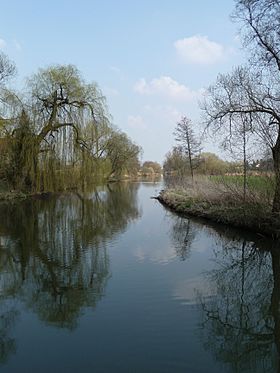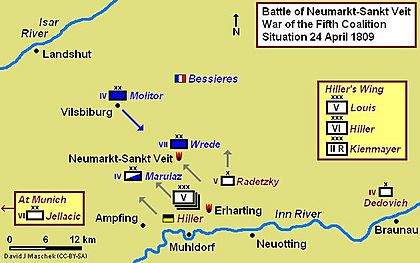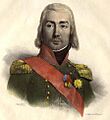Battle of Neumarkt-Sankt Veit facts for kids
Quick facts for kids Battle of Neumarkt-Sankt Veit |
|||||||
|---|---|---|---|---|---|---|---|
| Part of the War of the Fifth Coalition | |||||||
 Rott River near Oberdietfurt, 10 km downstream. The Bavarians suffered heavy losses while retreating across the Rott. |
|||||||
|
|||||||
| Belligerents | |||||||
| Commanders and leaders | |||||||
| Strength | |||||||
| 27,000 to 28,000 | 18,000-20,661 Add strengths of Jacquinot, Molitor, Marulaz, and Wrede. Casualties unknown for 19–23 April. | ||||||
| Casualties and losses | |||||||
| 800-1,000 | 2,500-2,602 | ||||||
The Battle of Neumarkt-Sankt Veit happened on April 24, 1809. It was a fight between the Austrian Empire army and a combined force of French and Bavarian soldiers. The Austrian army was led by Johann von Hiller. The French and Bavarian troops were commanded by Marshal Jean-Baptiste Bessières.
Hiller's Austrian army had more soldiers and won the battle. They forced Bessières' troops to retreat. The battle took place near Neumarkt-Sankt Veit in what is now Germany. This area is about 10 kilometers (6 miles) north of Mühldorf.
This battle was part of the War of the Fifth Coalition. This war began when Archduke Charles, Duke of Teschen of Austria surprised Emperor Napoleon I of France by invading Kingdom of Bavaria on April 10, 1809.
Contents
The War Begins: Napoleon's Early Battles
When Archduke Charles invaded Bavaria, Napoleon's army was not ready. On April 19, Charles missed a chance to defeat a part of Napoleon's army. Instead, a tough fight happened at the Battle of Teugen-Hausen.
On April 20, the Austrian army's left side was spread out along the Abens River. This part of the army included about 42,000 soldiers. Napoleon attacked with 55,000 troops in the Battle of Abensberg. He caused many losses for the Austrians and made them retreat.
Johann von Hiller was in charge of the Austrian left side. He decided to keep moving southeast towards Landshut. This move separated his troops from Archduke Charles' main army near Regensburg.
Napoleon Pursues the Austrians
Napoleon defeated Hiller again at the Battle of Landshut on April 21. He captured a crossing over the Isar River. This pushed the Austrians even further southeast. For a short time, Napoleon thought Hiller's troops were the main Austrian army.
But then, Napoleon realized his mistake. He quickly sent most of his army north to fight Archduke Charles. On April 22, Napoleon's French and German forces beat Charles at the Battle of Eckmühl. Charles' army had to retreat across the Danube River.
Napoleon then told Marshal Bessières to chase Hiller's retreating Austrian forces. Bessières had a cavalry division and two infantry divisions.
Hiller's Counterattack
On April 23, Hiller's main force, about 27,000 to 28,000 soldiers, was near Mühldorf. Another 10,000 Austrian soldiers were in Munich. Hiller noticed that the French chase had slowed down. He decided to turn around and attack.
A letter from Emperor Francis I encouraged Hiller to help protect Archduke Charles' army. Neither Hiller nor the Emperor knew that Charles had already moved his army to the north side of the Danube River.
The Battle of Neumarkt-Sankt Veit
On the night of April 22, Napoleon ordered Bessières to advance. Bessières had Bavarian soldiers led by Lieutenant General Karl Philipp von Wrede. He also had French infantry led by General of Division Gabriel Jean Joseph Molitor and cavalry led by General of Brigade Jacob François Marulaz. Napoleon wanted them to cross the Inn River and capture Braunau am Inn.
Bessières and Wrede's Bavarian soldiers reached Neumarkt-Sankt Veit on April 22. From there, Bessières sent Marulaz to scout towards the Inn River.
Late on April 23, Hiller crossed the Inn River again at Mühldorf. He ordered another Austrian general to advance from Munich towards Landshut. Marulaz's scouting group met Hiller's leading troops near Mühldorf. The French cavalry were pushed back. Marulaz then pulled his forces back towards Neumarkt-Sankt Veit.
On the morning of April 24, Hiller attacked with three groups of soldiers. His right group attacked Wrede's Bavarians at 8:00 am. Wrede's soldiers were on high ground southeast of Neumarkt. Hiller's middle group attacked Marulaz's cavalry and pushed them back too.
Wrede's Bavarians fought hard and held their ground until noon. But the Austrian attacks threatened to surround them. Bessières ordered a retreat around 1:00 pm. Molitor's French soldiers arrived and helped cover Wrede's retreat.
However, the Austrians kept pushing hard. They captured Neumarkt around 3:00 pm. Wrede's soldiers lost many men as they crossed the Rott River. Once Bessières' forces were across the river, Hiller stopped the battle. Bessières then retreated in an orderly way to Vilsbiburg.
Aftermath of the Battle
The Austrians lost about 800 to 1,000 soldiers killed or wounded. The French and Bavarians lost around 2,500 to 2,600 soldiers killed, wounded, or captured.
On the night of April 24, Hiller learned that Archduke Charles' main army had been defeated. Hiller immediately pulled his troops back to Neuötting.
The Austrian general who was supposed to threaten Landshut also found out about Charles' defeat. He left Munich on the evening of April 23. Later, a French army corps crushed his division at the Battle of Sankt Michael on May 25.
When Napoleon heard about the Battle of Neumarkt-Sankt Veit, he sent more troops to support Bessières. But by then, Hiller was already retreating quickly to the east. The next big battle was the Battle of Ebelsberg on May 3.
Images for kids







